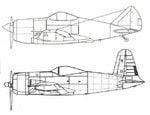As usually, a what-if 
So you are mover shaker in USAAC, and you want to have best hardware, in good numbers, for your service country. What 2 types would you choose to build, with main parts to be Made in USA? So no DB 601s, no Hispano 20mm etc.
The two types would be a kind of hi-low mix, one featuring the best combo US companies had to offer, and second featuring more 'common' parts, so your government can sell stuff abroad more easily economically.
As stated, you need a good force of fighter planes before 1942. Choice is not restricted to the types historically available, so you can mix match parts.
EDIT: Since I agree with our Shortround6 that P-38 P-40 were good choices, I'd like to alter the thread so that it covers only SINGLE engined jobs. Still 2 types (hi-tech off-the-shelf) required
So you are mover shaker in USAAC, and you want to have best hardware, in good numbers, for your service country. What 2 types would you choose to build, with main parts to be Made in USA? So no DB 601s, no Hispano 20mm etc.
The two types would be a kind of hi-low mix, one featuring the best combo US companies had to offer, and second featuring more 'common' parts, so your government can sell stuff abroad more easily economically.
As stated, you need a good force of fighter planes before 1942. Choice is not restricted to the types historically available, so you can mix match parts.
EDIT: Since I agree with our Shortround6 that P-38 P-40 were good choices, I'd like to alter the thread so that it covers only SINGLE engined jobs. Still 2 types (hi-tech off-the-shelf) required
Last edited:


